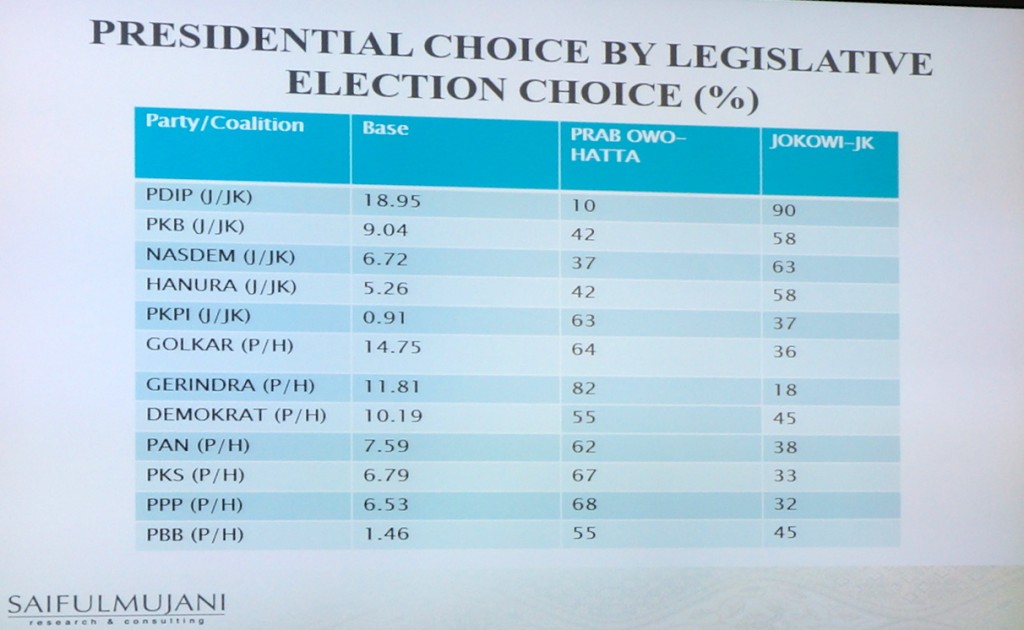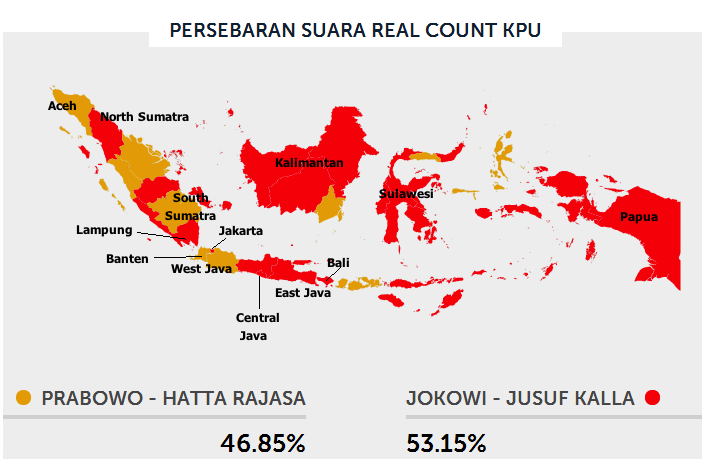Last Thursday, the United States-Indonesia Society and the International Republican Institute held a briefing of data from R. R. William Liddle, a professor emeritus of political science at The Ohio State University and one of the leading US experts on Indonesian politics, government and culture. ![]()
Dr. Liddle brought with him a compelling set of exit polling data conducted by Saiful Mujani, a Jakarta-based research and consulting firm.
The data provided the strongest narrative details yet for how Jakarta governor Joko Wododo (‘Jokowi’) effectively outpaced former general Prabowo Subianto in what was Indonesia’s most fiercely and closely contested election since the introduction of direct voting for the presidency in 2004.
For example, it may be counterintuitive, but younger, urban voters appeared to prefer, by a slight margin, Prabowo to Jokowi. After all the talk of Jokowi as the younger candidate of hope and of reform, the ‘Barack Obama’ of Indonesia after his meteoric rise from Solo mayor to Jakarta governor to, now, president-elect, it isn’t necessarily intuitive that Jokowi edged his way to the Indonesian presidency on the support of relatively poorer, rural and older voters.
Voters by age
Voters under 21 years old supported Jokowi by a margin of just 53% to 47%, but voters over 55 supported Prabowo by a margin of 59% to 41%. Though you might expect younger voters to be most enthusiastic for a relatively young, modern president, they opted for Prabowo, nine years Jokowi’s senior.
One possibility is that younger voters don’t entirely remember Indonesia’s authoritarian age, but older voters remember only too well the human rights abuses of Suharto’s three-decade reign and, most especially, the economic pain of the financial crisis of 1997-99 that brought down Suharto’s ‘New Order.’ Given Prabowo’s ties to the regime — he was a top Suharto-era general and he used to be married to Suharto’s daughter — older voters might have been warier about supporting the former general, given his checkered past.
Rural and urban voters and voters by class
Rural voters preferred Jokowi by a margin of 56% to 44%, but Prabowo narrowly won urban voters by a margin of 51% to 49%. The data also showed that ‘white-collar’ voters supported Prabowo by 55% to 45%, while ‘blue-collar’ voters backed Jokowi by 54% to 46%.
Again, it’s a fascinating turn, considering Prabowo’s emphasis on economic nationalism that, in most countries, finds a greater audience among the least economically powerful. Wall Street bankers and investment attorneys in the United States, for example, are much less likely to support protectionist policies than, say, blue-collar ironworkers or manufacturers who acutely feel the sting of global competition.
As Liddle noted, there might be several reasons for Prabowo’s apparent strength among educated, successful, cosmopolitan Indonesians. One of them is the way that Jokowi framed himself as a ‘common man’ candidate — not a president who, like Prabowo, comes from the Indonesian elite, educated in international schools and has exquisite English-language skills. Prabowo, throughout the campaign, effectively demonstrated that his much greater exposure to the United States and the wider world, and many cosmopolitan voters found that quality reassuring.
Voters by religion
Islamic voters narrowly favored Prabowo by a margin of 51% to 49%, while non-Islamic voters overwhelmingly backed Jokowi by an 80% to 20% margin. That’s not surprising, given that three of the four major Islamist parties backed Prabowo and that his running mate, Hatta Rajasa, former coordinating minister for economics, is the leader of the Islamist Partai Amanat Nasional (PAN, National Mandate Party). It’s also not surprising in light of the whispering campaign that Jokowi is secretly Christian. The predominantly Hindu island of Bali, for example, has always been a stronghold for Jokowi’s party, the Indonesian Democratic Party of Struggle (PDI-P, Partai Demokrasi Indonesia Perjuangan), and Jokowi did particularly well in predominantly Christian areas, such as Papua. It also explains why Prabowo won Indonesia’s most populous province, West Java, home to some of Indonesia’s most conservative Muslims — with 46.3 million people, West Java contains nearly 19% of the country’s population.
The Javanese-Sundanese split
The data indicate that Jokowi triumphed among the Javanese by a margin of 56% to 44%, while Prabowo won the Sundanese by a margin of 80% to 20%. That explains why, despite Prabowo’s West Java breakthrough, with a heavy Sunda population, Jokowi narrowly won Jakarta (9.6 million) and East Java (37.5 million), and he racked up an even more solid victory in Yogyakarta (3.5 million) and Central Java (32.4 million), the traditional Javanese homeland. Among non-Javanese and non-Sundanese voters, Jokowi won by a margin of 53% to 47%. While Prabowo generally won more provinces in Sumatra, for example, Jokowi won the most populous province, North Sumatra (13 million), and Jokowi’s running mate Jusuf Kalla may have helped Jokowi win much of the island of Sulawesi.
The most interesting finding of the survey, though?
Voters by party identification
To me, it’s the breakdown of how voters chose a presidential candidate on the basis of their identification with a particular party in Indonesia.
Due to Indonesia’s complex election rules (rule that are set to expire in the 2019 election season), voters participate in legislative elections in the spring, and the basis of a party’s strength thereupon determine whether it can field a presidential candidate.
Accordingly, in April, Indonesians elected all 560 members of the Dewan Perwakilan Rakyat (DPR, People’s Representative Council). Following the elections, each party must either claim 25% of the national vote or hold 20% of the seats in the DPR in order to field a presidential candidate — or find allies to support it in a presidential coalition.
The PDI-P, in first place with 109 seats, easily moved forward to nominate Jokowi with a handful of allies.
Prabowo, as the strongest challenger to Jokowi, also progressed with his candidacy under the strength of his party, Gerindra (Partai Gerakan Indonesia Raya, the Great Indonesia Movement Party), which placed third in April with 73 seats.
That left a handful of smaller parties; the four major Islamist parties; the party of outgoing president Susilo Bambang Yudhoyono, the Partai Demokrat (Democratic Party), far behind in fourth place with 61 seats; and the Partai Demokrat (Democratic Party); and the reconstituted party that dominated politics in the Suharto era, Golkar (Partai Golongan Karya, Party of the Functional Groups) — with 91 seats, the second-largest force in the DPR.
You can see how voters, closely identified with the parties, lined up behind either Jokowi or Prabowo in the race.
It’s not a surprise that 90% of PDI-P partisans supported Jokowi or that 82% of Gerindra supporters backed Prabowo or that, on average, supporters of the three pro-Prabowo Islamist parties backed Prabowo by a margin of 66% to 34%.
What tells us the most about Indonesian politics going forward are the margins of voters identified as Democrat and Golkar supporters.
Yudhoyono’s Democrats only backed Prabowo at the last minute when the former general was gaining momentum in the polls at Jokowi’s expense, and apparently, the Democrats’ grassroots supporters were equally tepid. They only backed Prabowo by a margin of 55% to 45%.
Golkar’s official leadership, including Aburizal Bakrie, the current leader, one of the country’s wealthiest businessman, backed Prabowo. But Jusuf Kalla, a former Golkar leader and previously vice president under Yudhoyono from 2004 to 2009, ran (successfully) as Jokowi’s running mate. The data indicates that Golkar’s supporters backed Prabowo by a margin of just 64% to 36%. That suggests that the Golkar party machine was only able to bring just under two out of every three strong Golkar supporters.
Though Aburizal’s leadership is today very much in jeopardy for having backed the losing candidate — and for causing a split within Golkar after Kalla ran on Jokowi’s presidential ticket — it’s clear that Golkar’s somewhat unexpected decision to pull its weight (and Aburizal’s significant media ownership and influence) behind Prabowo is one of the reasons the race tightened so much in the final weeks of the campaign.
It also shows how smart, planned or unplanned, it was for Golkar to have a foot in both the Jokowi and Prabowo camps. Though Kalla’s supporters will now presumably push Aburizal out of the Golkar leadership and line up in Jokowi’s governing coalition between now and the October inauguration, you can easily see how indebted Prabowo would have been to Aburizal and Golkar’s party apparatus in the event that Prabowo had won the election.

